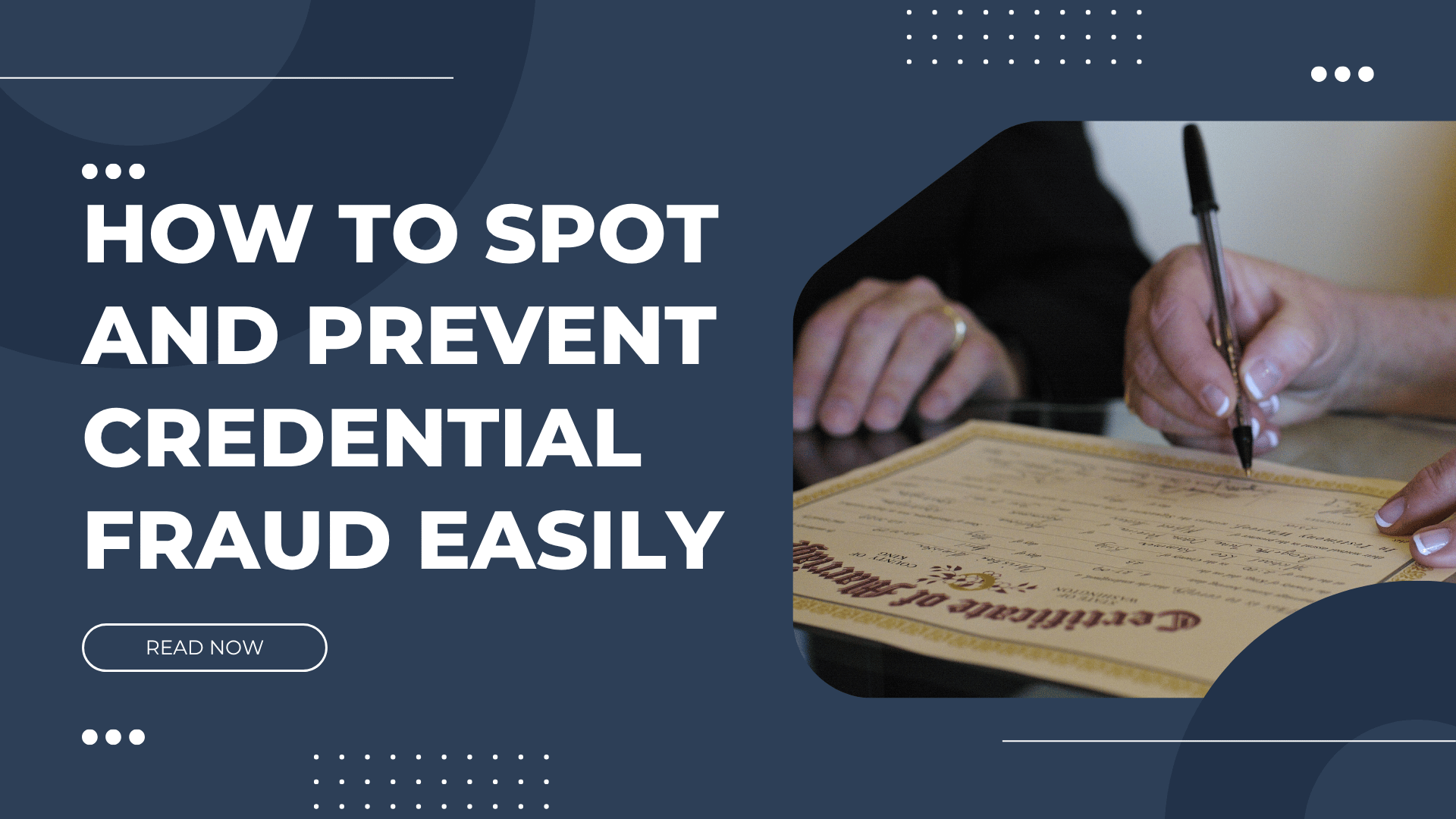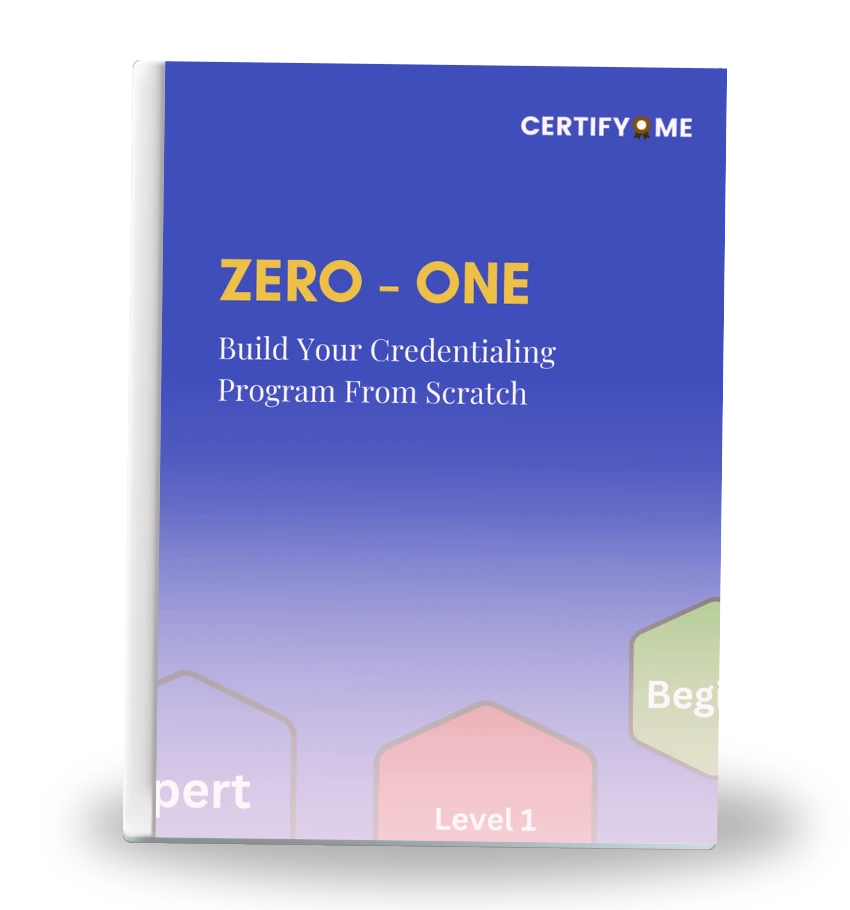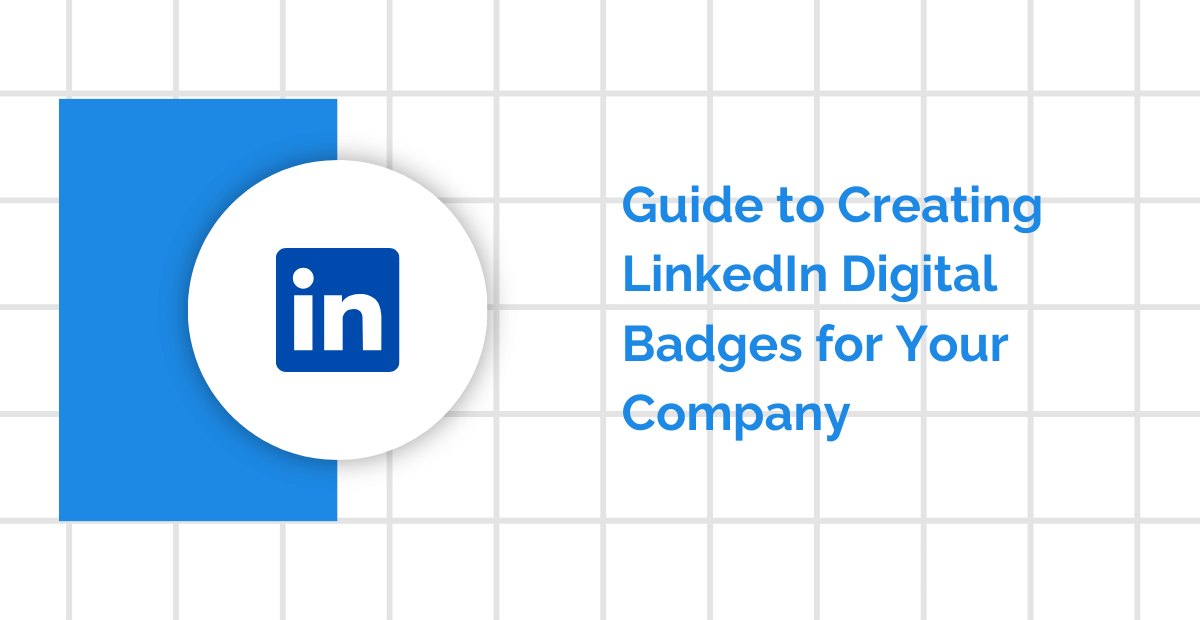Ever wonder how easy it is for someone to fake a diploma or tweak a certificate just enough to get away with it?
It’s more common than you’d think—and the scary part is, it’s not always easy to spot. People have used fake degrees to land jobs, win scholarships, or even get into grad school. As someone who’s worked with both students and registrar offices, I’ve seen just how much damage one forged document can do lost trust, bad hires, and messy records that take months to sort out.
That’s why this blog breaks it all down, in plain language, and shows you how to spot, stop, and stay ahead of credential fraud.
Understanding Certification and Credential Fraud
Let’s start with the basics—what exactly is credential fraud?
Simply put, it’s when someone lies about their academic or professional qualifications. It could be as bold as forging a diploma, or as subtle as exaggerating skills on a resume with fake certificates.
Either way, it leads to the same thing: a dishonest advantage at the cost of someone else’s hard-earned effort.
This type of fraud isn’t just rare or limited to extreme cases. In fact, it’s shockingly common. From fake universities selling degrees to individuals tweaking their transcripts, fraudsters are finding loopholes—and fast.
According to a study by Accredibase, more than 2,600 unaccredited institutions were active globally, many of which target students and employers with official-looking but fake documents.
The impact? Pretty serious. Fraudulent credentials damage trust, mess with hiring and admissions decisions, and put institutions’ reputations at risk. For example, when an employer hires someone based on fake skills, it doesn’t just affect team performance—it can lead to costly mistakes or even legal issues. For schools, it erodes credibility, makes records harder to manage, and opens up the risk of non-compliance with accreditation bodies.
And for students—the honest ones? Credential fraud devalues their genuine achievements. When everyone claims to have a certificate, the real thing loses its meaning. That’s why understanding how this fraud works isn’t just useful—it’s essential.
What Is Certification Fraud?
At its core, certification fraud is when someone lies about their qualifications by presenting fake or altered documents. These documents could be anything from diplomas and transcripts to certificates from online courses.
Sometimes, it’s done with full intent—buying a degree from a diploma mill or editing a PDF. Other times, it’s more subtle, like listing a course as “completed” when only a few modules were attended.
The tactics may vary, but the goal is the same: to gain access to something the person hasn’t rightfully earned, whether that’s a job, a scholarship, or admission into a program. And make no mistake, this isn’t just a harmless fib. It can lead to unqualified individuals being hired, receiving credentials, or gaining trust they haven’t earned—posing real risks to institutions and employers.
What makes this type of fraud particularly tricky is how convincing fake credentials can look. With access to design tools, blank templates, and even stolen registrar seals, bad actors can replicate documents that look almost identical to the real thing.
Unless there’s a robust verification system in place, spotting the difference becomes a game of guesswork—and that’s not a game schools or employers should be playing.
This deceit can occur through various means, including:
-
Diploma Mills: Unaccredited institutions that offer degrees with little to no academic requirements.
-
Document Forgery: Altering legitimate documents to inflate grades or achievements.
-
Identity Misrepresentation: Using someone else’s credentials to gain employment or admission.
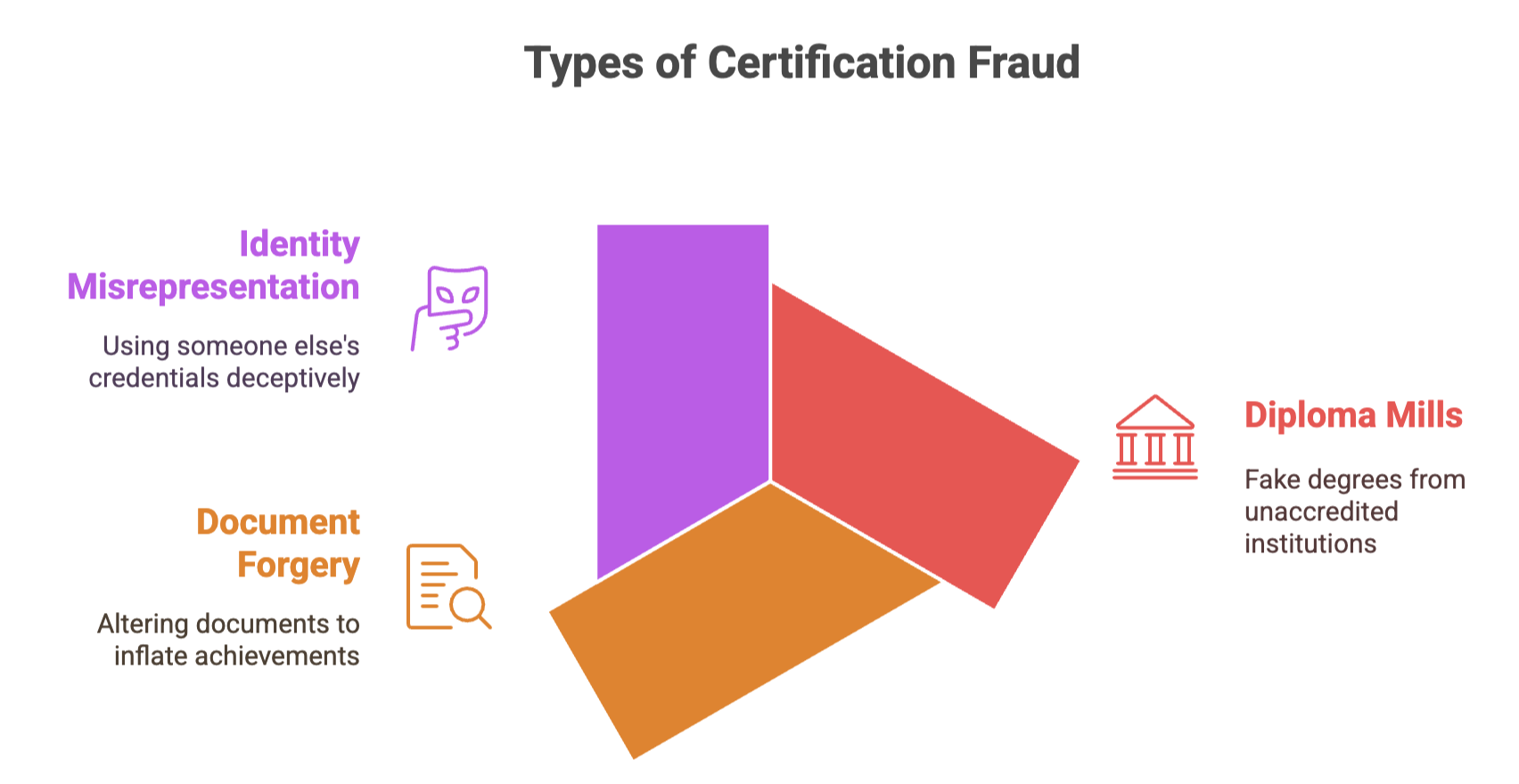
The Prevalence of the Issue
You might think credential fraud is something rare—something that happens in far-off places or only to big institutions. But the numbers say otherwise.
According to the Association of Certified Fraud Examiners (ACFE), global losses due to occupational fraud, including credential fraud, exceeded $3.1 billion between January 2022 and September 2023. That’s not just a statistic—it’s a wake-up call.
What’s more concerning is how long these frauds go unnoticed. The average fraud case lasted about 12 months before being caught, and by then, the damage—financial, reputational, and operational—was already done.
Think about it: someone using a fake degree could be making decisions, leading teams, or even performing sensitive work, all while lacking the qualifications they claim.
And it’s not always a high-tech scam. Often, it’s as simple as printing a forged certificate, editing a PDF, or buying a fake diploma from a “degree mill.” These scams are easy to find online and surprisingly cheap, which lowers the barrier for bad actors.
Unfortunately, that means every institution—whether a major university or a small community college—is vulnerable unless preventive steps are taken.
Traditional Verification Methods: Limitations and Challenges
Now, you might wonder—don’t we already have ways to verify certificates? Yes, we do.
But here’s the catch: most traditional methods are slow, manual, and easy to fool. They weren’t built for today’s fast-moving, digital-first world.
Let’s take an example. Imagine a registrar’s office manually confirming a graduate’s records by email or over the phone. That means digging through files, cross-checking transcripts, and sometimes faxing forms back and forth. It’s time-consuming, prone to human error, and frankly, exhausting when you’re handling hundreds of verifications a month.
Not to mention—these systems aren’t tamper-proof. Paper-based documents can be forged. PDFs can be edited. Even digital files without a secure verification link can be faked and re-used. There’s no quick, universal way for someone—say, an employer or admissions officer—to instantly know that a document is legit.
Also, there’s a privacy angle. Traditional methods often involve sharing sensitive student data over unsecured channels like email. That’s risky. Especially in the age of data breaches, where a single slip could expose personal details or cause major trust issues.
So, while these methods served their purpose once, they simply can’t keep up with today’s credentialing needs. Institutions need faster, more secure, and more reliable solutions—and that’s where modern, digital approaches come into play.
Manual Verification Processes
Historically, verifying academic credentials has been a manual process involving:
-
Physical Document Inspection: Reviewing paper transcripts and certificates.
-
Direct Communication: Contacting issuing institutions for confirmation.
-
Reference Checks: Speaking with previous employers or educators.
Challenges with Traditional Methods
Traditional methods of verifying academic records—like checking physical copies, making phone calls, or sending emails—might seem dependable, but in reality, they’re slow, inconsistent, and often unreliable.
Sure, they’ve been used for decades. But in today’s digital age, where decisions happen fast and fraudsters are getting smarter, they leave a lot of room for error.
For one, manual processes take time. A registrar may need to dig through archived files, confirm signatures, and respond to countless requests—all while juggling other administrative duties. When hundreds of verifications pile up, backlogs are inevitable. It slows everything down, from hiring to admissions, causing frustration for everyone involved.
And then there’s the issue of human error. One mistyped email address. One overlooked detail. One missed phone call. That’s all it takes for fraud to slip through the cracks. Add to that the lack of standardization—each school or employer might verify records differently—and you get a system that’s inconsistent and easy to exploit.
Lastly, traditional verification doesn’t come with built-in security. Paper can be copied. PDFs can be edited. Emails can be faked. Without embedded verification tools or encrypted tracking, you’re relying on surface-level trust—which isn’t always enough. In short, old methods leave both students and institutions vulnerable in ways they can no longer afford.
These conventional methods present several drawbacks:
-
Time-Consuming: Manual checks can delay hiring or admissions processes.
-
Prone to Human Error: Mistakes in verification can lead to overlooking fraudulent documents.
-
Lack of Standardization: Different institutions have varying verification protocols, leading to inconsistencies.

Enter Digital Credentials (The Smarter Way to Verify)
It’s time to face the facts—paper certificates just don’t cut it anymore. They’re easy to damage, easier to forge, and frankly, hard to keep track of in today’s fast-paced, online-first world.
That’s where digital credentials come in. Think of them as the modern, secure version of your transcript or diploma—only smarter and a lot harder to fake.
At their core, verifiable digital credentials are records of academic or professional achievement stored electronically, offering secure, tamper-proof, and instantly shareable alternatives to paper-based documents.
Whether it’s a diploma, a certificate of course completion, or a skill badge earned through a workshop, these credentials are designed to be both easily shareable and instantly checkable. No more mailing paper copies. No more waiting on a registrar’s reply.
But the real beauty lies in what they prevent—tampering. Digital credentials are issued directly by the institution, tied to a recipient’s identity, and often include metadata like the date, issuer, and achievement level.
Some even come with QR codes or embedded verification links. So instead of asking, “Can we trust this?” you can click once and know it’s real.
What Are Digital Credentials?
Digital credentials are electronic representations of academic achievements, securely stored and easily shareable. They often include:
-
Digital Diplomas: Official digital versions of academic degrees.
-
Certificates of Completion: Proof of course or program completion.
-
Digital Badges: Icons representing specific skills or accomplishments.
Advantages of Digital Credentials
Let’s face it: paper credentials just weren’t built for the digital world we live in. They’re easy to lose, hard to verify, and even easier to forge. That’s where digital credentials come into play, offering a smarter, safer, and more efficient way to prove learning outcomes and qualifications.
For starters, digital credentials offer enhanced security. They’re often encrypted and tied to the issuer’s system, making it virtually impossible to alter them without detection.
Unlike paper certificates or editable PDFs, these credentials typically come with a verification link or QR code that instantly confirms authenticity. So instead of sending an email or making a phone call, an employer or admissions officer can just click once—and know.
Another major benefit is portability. Graduates can store and share their credentials in digital wallets, online resumes, LinkedIn profiles, or applications. This makes job-seeking, applying to further studies, or even transferring schools much more seamless. For students constantly on the move (and often juggling multiple roles), that flexibility matters.
Last but not least, digital credentials make life easier for institutions too. With automated issuance and instant verification, registrar offices can reduce manual workload, avoid backlogs, and focus more on student support rather than paperwork.
It’s not just about stopping fraud—it’s about upgrading the whole system to fit today’s reality.
Summarising the numerous benefits to:
-
Enhanced Security: Digital credentials are harder to forge than paper documents.
-
Immediate Verification: Employers and institutions can instantly validate credentials online.
-
Portability: Graduates can easily share their credentials with potential employers or institutions.
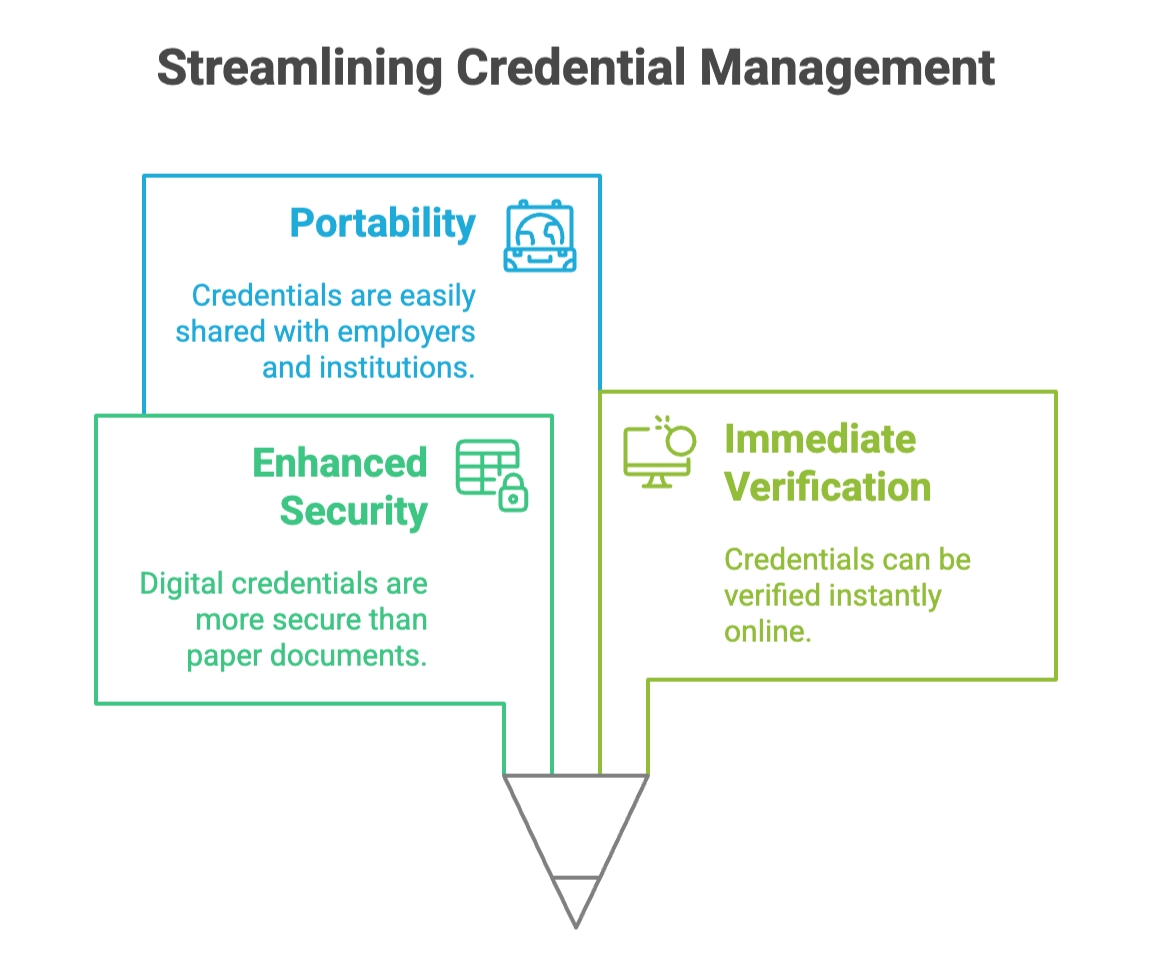
The Role of Blockchain in Credential Verification
Now let’s talk about the tech that makes digital credentials really secure: blockchain. You’ve probably heard about it in the context of cryptocurrency, but here, it’s used in a completely different way.
At its simplest, blockchain is just a super-secure way to store information—once something’s recorded on it, it can’t be changed.
Here’s how that helps with credentials. When a university issues a digital diploma using blockchain, it gets stored in a kind of digital ledger that’s spread across many computers. No one person or office can go back and quietly change it. And because it’s public and transparent (but still respects privacy), employers or other schools can check the record without needing to call up the registrar.
Some big names are already using it. MIT, for example, uses the Bitcoin blockchain to issue digital diplomas that students can carry in their digital wallets or share on LinkedIn. The University of Lille in France is using blockchain to issue bilingual credentials. And Grand Valley State University recently launched a pilot project for a credential wallet that gives students more control over how and when they share their records.
What this means is simple but powerful: no one can fake what’s been recorded on the blockchain. That one change flips the power dynamic—it puts the control (and the truth) back in the hands of the issuer and the recipient.
Several institutions—and even public bodies—have adopted blockchain for credentialing. Government-backed digital credentials are also emerging as secure solutions for identity and qualification verification at scale.
Understanding Blockchain Technology
Blockchain is a decentralized ledger system that records transactions across multiple computers. Once data is recorded, it cannot be altered retroactively, ensuring transparency and security.
Application in Academic Credentials
By leveraging blockchain, educational institutions can:
-
Issue Tamper-Proof Credentials: Once a credential is recorded on the blockchain, it cannot be modified, ensuring authenticity.
-
Facilitate Instant Verification: Employers can verify credentials without contacting the issuing institution.
-
Enhance Trust: The decentralized nature of blockchain reduces the risk of centralized data breaches.
Real-World Implementations
Several institutions have adopted blockchain for credentialing:
Massachusetts Institute of Technology (MIT): Offers digital diplomas verified through the Bitcoin blockchain.
University of Lille: Provides bilingual, tamper-proof digital credentials using blockchain technology.
Grand Valley State University: Launched a pilot for a blockchain-based digital credential wallet, granting students greater control over their academic records.
Best Practices for Students and University Staff
Fighting credential fraud isn’t just about having the right tools—it’s also about knowing how to use them. Whether you’re a student earning new qualifications or a registrar managing records, a few smart habits can go a long way in keeping credentials secure.
If you’re a student, start by checking that your school is properly accredited. Stick with recognized institutions, and when you receive a digital credential, store it safely. Use platforms that let you share a verifiable link rather than just uploading a screenshot. Stay informed about new digital tools—what’s secure today might be outdated tomorrow.
If you work in university admin, your role is even more critical. Use trusted platforms that issue blockchain-backed credentials and train staff to verify them properly. Host workshops or quick info sessions for students and faculty to explain how these credentials work. And don’t forget to audit your systems regularly—a small vulnerability can quickly turn into a big breach.
At the end of the day, preventing fraud is a shared responsibility. With the right tools, clear communication, and up-to-date practices, universities and students can protect their achievements—and the trust that comes with them.
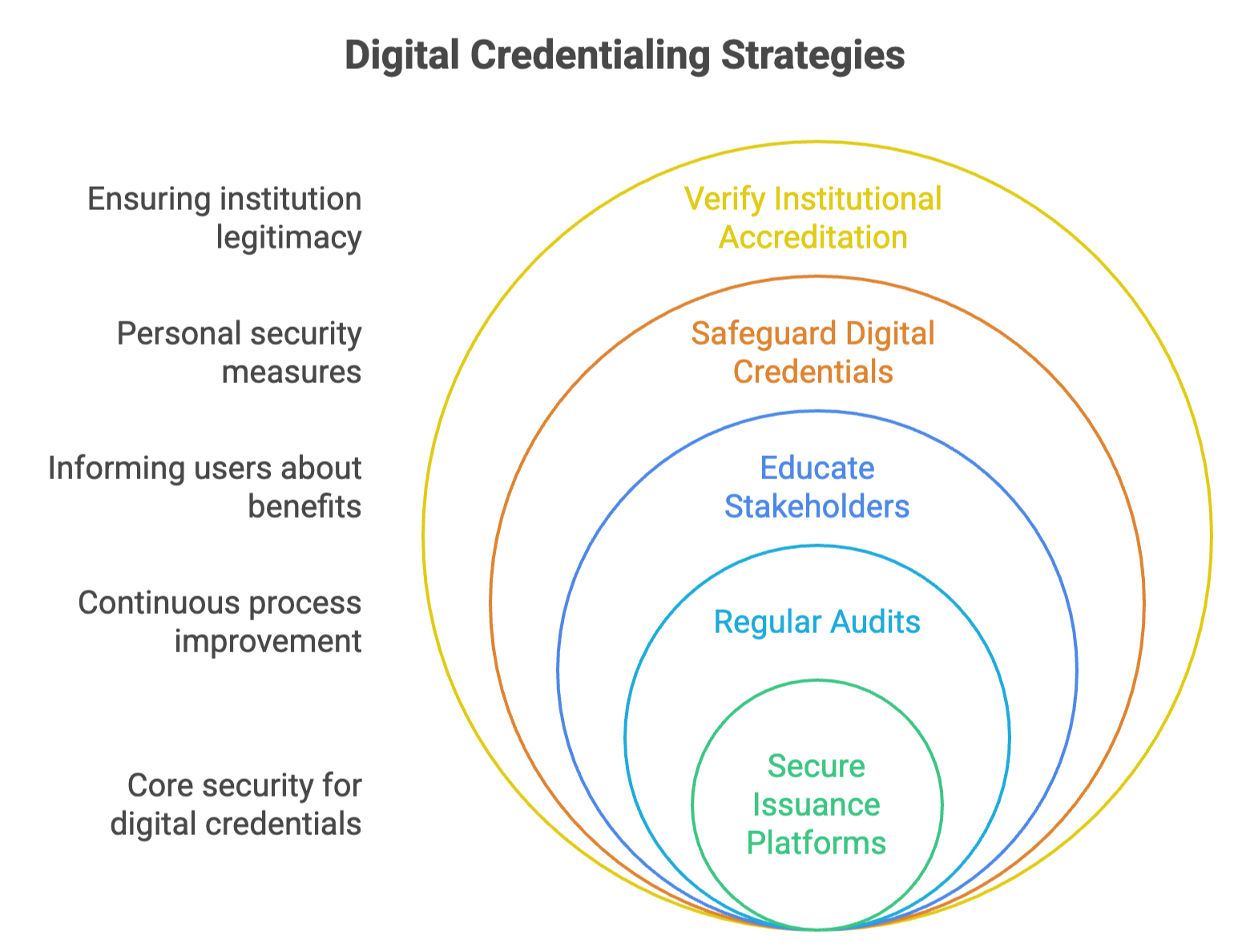
For Students
-
Verify Institutional Accreditation: Ensure that the institution you’re attending is recognized by relevant educational authorities.
-
Safeguard Digital Credentials: Store your credentials securely and be cautious when sharing them.
-
Stay Informed: Regularly check for updates on digital credentialing practices and technologies.
For University Staff
-
Adopt Secure Issuance Platforms: Utilize platforms that offer blockchain-based credentialing to enhance security.
-
Educate Stakeholders: Inform students and employers about the benefits and verification processes of digital credentials.
-
Regular Audits: Periodically review credentialing processes to identify and rectify potential vulnerabilities.
Use trusted platforms that issue blockchain-backed credentials and train staff to verify them properly. Learn how a digital credential management platform can streamline issuance, verification, and secure sharing processes.
Conclusion
Preventing certification and credential fraud isn’t just a tech issue—it’s a trust issue.
When documents can be faked, everyone loses: students, schools, and future employers. That’s why it’s so important to understand how fraud happens and what tools are out there to stop it. From diploma mills to document tampering, knowing the risks is the first step.
The good news? There are smarter, safer ways to issue and verify academic records now.
Digital credentials—especially those backed by blockchain—help keep things honest by making it easy to prove what’s real and what’s not. And once universities and employers get on board, it becomes a whole lot harder for fake documents to slip through the cracks.
Digital credentials—especially those backed by blockchain—help keep things honest by making it easy to prove what’s real and what’s not. To understand how this field is evolving, explore the future of digital credentials and how emerging tech continues to shape academic verification.
If you’re looking for a way to make your institution’s credentials more secure, CertifyMe is worth checking out. It helps universities issue tamper-proof digital certificates that are easy to share and even easier to verify. Plus, it takes the pressure off admin staff by cutting out manual checks.
Want to see how it works? Book a demo and explore how CertifyMe can help protect your records—and your reputation.
Today, proof matters more than claims. And with digital credentials, you don’t just say you did it—you show it.

 Author :
Author : 